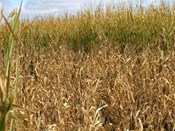Corn Rootworm Resistance to BT-Corn Reported
Elson Shields, Department of Entomology, Cornell University
Since the introduction of BT-corn varieties, concern has been raised by entomologists about the target insect developing resistance to the incorporated toxin and causing significant plant damage to those protected plants. With the initial introduction of BT-corn borer varieties, the concept of a non-treated refuge was also introduced. Insects produced from an untreated refuge are not exposed to the toxin and suppress the development of resistance by interbreeding with any BT toxin survivors.
Area wide populations of corn borer have plummeted throughout the Corn Belt and have remained low for the past 15 years. The insect mating behavior outside the field coupled with the establishment of some refuges within areas seems to have suppressed the development of resistance to the plant incorporated BT. In contrast, this insect is capable of developing resistance in the laboratory within a few generations.
The situation with western corn rootworm appears to be completely different.
Since CRW BT-toxin introduction in 2003, the speed of resistance development has been debated among scientists because corn rootworm has a different mating/dispersal behavior than corn borer and rootworm has a history of developing resistance to other insecticides. Attempts by public scientists to study the potential development of corn rootworm-BT resistance were significantly hampered by seed industry legal restrictions placed on public scientists, limiting both laboratory and field research from the mid-1990s until 2010. Widespread and organized objections by corn entomologists from major agricultural universities in 2010, convinced the seed companies to loosen the legal restrictions limiting research by public scientists involving GMO crops. As a result, the 2009 observation of trait failure in southern Minnesota became public in 2010 and corn rootworm resistance to the BT trait was verified in the laboratory at Iowa State during 2010 and 2011.
In addition, multiple observations across large areas of the Corn Belt are reporting a rebounding rootworm population in fields planted with BT-CRW corn varieties. Starting in 2009 and extending through 2012, corn entomologists started reporting a rise in the adult rootworm population but widespread root injury has not been reported. This widespread rebound of the insect population strongly suggests that the insect is surviving the toxin better and more larvae are surviving into adult beetles. These observations also suggest that a widespread increase in trait failure maybe “just around the corner.” These recent observations are in contrast to the widespread CRW population crash which occurred in response to the area wide planting of CRW-BT corn between 2004 and 2009.
Now that resistance has been documented in the Corn Belt to CRW-BT, the discussion shifts to management alternatives. Since many seed companies have placed their elite yield genetics in varieties along with BT toxins for corn borer and rootworm, growers have little choice but to plant the BT varieties if they want higher yielding corn. If the BT toxin is failing, additional management alternatives need to be layered over the BT toxin. Many producers are choosing to apply soil insecticides on top of the BT-CRW corn varieties in order to reduce damage, thereby significantly increasing the cost of rootworm control.
How did resistance develop?
We believe there are two major contributing factors promoting the rapid development of CRW resistance to the BT toxin. 1) The expression of the toxin in the corn plant is not at a high dose level and 2) the widespread refusal of producers to plant a BT-free refuge as required by EPA as a condition of registration.
The less-than-high-dose of toxin in the plant allowed insects with a low level of resistance to survive the toxin, molt into adult insects, mate and lay eggs. The higher the toxin dose, the fewer insects initially survive and generally the longer it takes for the insect to develop resistance. The planting of untreated refuges produce large numbers of unexposed beetles to dilute any genetic resistance, thereby keeping the frequency of the resistance very low.
The lack of BT-free refuges allows the BT-toxin survivors to inter-mate and concentrate the genetic basis for resistance, allowing a larger portion of the population to survive the toxin each year, thus increasing the inter-mating between individuals with a lower level of resistance. As a result, individuals in each succeeding generation have an increased level of resistance to the toxin and have an increased survival. The cycle continues with each subsequent year.
Solutions?
Corn producers and the seed companies in the areas of rising insect resistance to CRW-BT have painted themselves into an interesting corner. It is very unlikely that management strategies can be implemented to reduce the level of insecticide resistance in corn rootworm to BT. Most of the new corn planters purchased do not have soil insecticide applicators, so the use of a soil insecticide to limit rootworm damage is not an option. High rates of seed treatment which work fine in the Northeast have a history of poor performance throughout most of the Corn Belt. The only solution open to most Midwest corn producers is to plant more CRW-BT toxin corn and make the resistance problem worse.
The majority of the documented failures involve only one of the two competing rootworm BT events. Seed companies selling corn varieties with both BT events incorporated into the same plant (SmartStax®) are selling these varieties as a solution to the resistance. When these dual toxin varieties are planted into an area with corn rootworm resistance present to one of the toxins, the use of these dual toxin varieties with their very small untreated refuge (5%) is believed to only accelerate resistance to the second toxin. We believe that when the dual toxin corn varieties are planted in areas of increasing rootworm populations or resistance areas, the untreated refuge needs to be increased to at least 20%.
Resistance in NY?
It is difficult to predict the future development or arrival of CRW-BT resistance in NY. Rapid resistance development is less likely because corn rootworm pressure in NY has never been as high as the Midwestern Corn Belt. As a result, market penetration for corn varieties with CRW-BT toxin has been significantly less with current estimates ranging between 30% and 50%, resulting in a much lower selection pressure on rootworm to develop resistance to the BT toxin. In addition, some NY farmers are still using the rootworm dose of seed treatment to control rootworm rather than planting a CRW-BT corn variety.
Recommendations to reduce the selection pressure on corn rootworm to develop resistance to CRW-BT corn:
- Only plant CRW-BT corn varieties in fields with high rootworm pressure. These fields are typically continuous corn fields in 3 or longer years of continuous corn. Choose a company which offers “Refuge-in-a-bag”. Susceptible seeds are mixed in the bag and the farmer is not required to plant a separate refuge.
- Fields with low levels of CRW pressure should be planted to a non-CRW-BT variety. These fields are typically first or second year fields. First year fields do not need any rootworm insecticide, but second year fields may need a high rate of seed treatment or a reduced rate of soil insecticide like Force®.
Re-printed from “What’s Cropping Up?” Volume 23, Number One January-February 2013.




